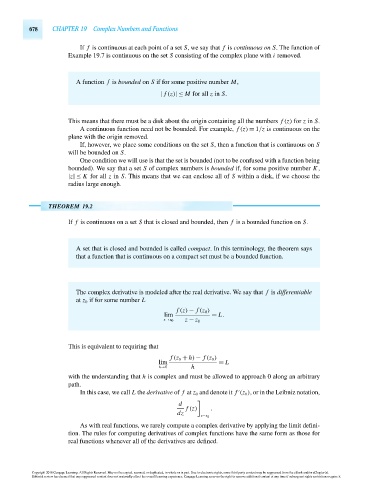Page 698 - Advanced_Engineering_Mathematics o'neil
P. 698
678 CHAPTER 19 Complex Numbers and Functions
If f is continuous at each point of a set S, we say that f is continuous on S. The function of
Example 19.7 is continuous on the set S consisting of the complex plane with i removed.
A function f is bounded on S if for some positive number M,
| f (z)|≤ M for all z in S.
This means that there must be a disk about the origin containing all the numbers f (z) for z in S.
A continuous function need not be bounded. For example, f (z) = 1/z is continuous on the
plane with the origin removed.
If, however, we place some conditions on the set S, then a function that is continuous on S
will be bounded on S.
One condition we will use is that the set is bounded (not to be confused with a function being
bounded). We say that a set S of complex numbers is bounded if, for some positive number K,
|z|≤ K for all z in S. This means that we can enclose all of S within a disk, if we choose the
radius large enough.
THEOREM 19.2
If f is continuous on a set S that is closed and bounded, then f is a bounded function on S.
A set that is closed and bounded is called compact. In this terminology, the theorem says
that a function that is continuous on a compact set must be a bounded function.
The complex derivative is modeled after the real derivative. We say that f is differentiable
at z 0 if for some number L
f (z) − f (z 0 )
lim = L.
z→z 0 z − z 0
This is equivalent to requiring that
f (z 0 + h) − f (z 0 )
lim = L
h→0 h
with the understanding that h is complex and must be allowed to approach 0 along an arbitrary
path.
In this case, we call L the derivative of f at z 0 and denote it f (z 0 ), or in the Leibniz notation,
d
f (z) .
dz
z=z 0
As with real functions, we rarely compute a complex derivative by applying the limit defini-
tion. The rules for computing derivatives of complex functions have the same form as those for
real functions whenever all of the derivatives are defined.
Copyright 2010 Cengage Learning. All Rights Reserved. May not be copied, scanned, or duplicated, in whole or in part. Due to electronic rights, some third party content may be suppressed from the eBook and/or eChapter(s).
Editorial review has deemed that any suppressed content does not materially affect the overall learning experience. Cengage Learning reserves the right to remove additional content at any time if subsequent rights restrictions require it.
October 15, 2010 18:5 THM/NEIL Page-678 27410_19_ch19_p667-694

